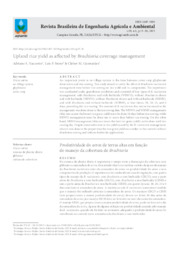Upland rice yield as affected by Brachiaria coverage management.
Upland rice yield as affected by Brachiaria coverage management.
Author(s): NASCENTE, A. S.; STONE, L. F.; GUIMARÃES, C. M.
Summary: An important point in no-tillage system is the time between cover crop glyphosate desiccation and rice sowing. This study aimed to verify the effect of Brachiaria ruziziensis management time before rice sowing on rice yield and its components. The experiment was conducted under greenhouse conditions and consisted of four types of B. ruziziensis management: with Brachiaria and with herbicide (WBWH), without Brachiaria shoots and with herbicide (NBWH), without Brachiaria shoots and without herbicide (NBNH), and with Brachiaria and without herbicide (WBNH), at four times: 30, 20, 10, and 0 days, preceding the rice sowing. The amount of B. ruziziensis dry matter increased as the management was done closer to the rice sowing date. The WBWH and WBNH managements (this one causes the lowest rice grain yield) must be done 30 days before rice sowing; while NBWH management must be done ten or more days before rice sowing. On the other hand, NBNH management (this one favors the best rice grain yield) can be done until rice sowing day. Despite some reduction in rice yield caused by the B. ruziziensis management, when it was done at the proper time the rice grain yield was similar to the control (without Brachiaria sowing and without herbicide application).
Publication year: 2015
Types of publication: Journal article
Unit: Embrapa Rice & Beans
Keywords: Arroz, Brachiaria, Glifosato, Oryza sativa, Planta de cobertura, Plantio direto
Observation
Some of Embrapa's publications are published as ePub files. To read them, use or download one of the following free software options to your computer or mobile device. Android: Google Play Books; IOS: iBooks; Windows and Linux: Calibre.
Access other publications
Access the Agricultural Research Database (BDPA) to consult Embrapa's full library collection and records.
Visit Embrapa Bookstore to purchase books and other publications sold by Embrapa.

